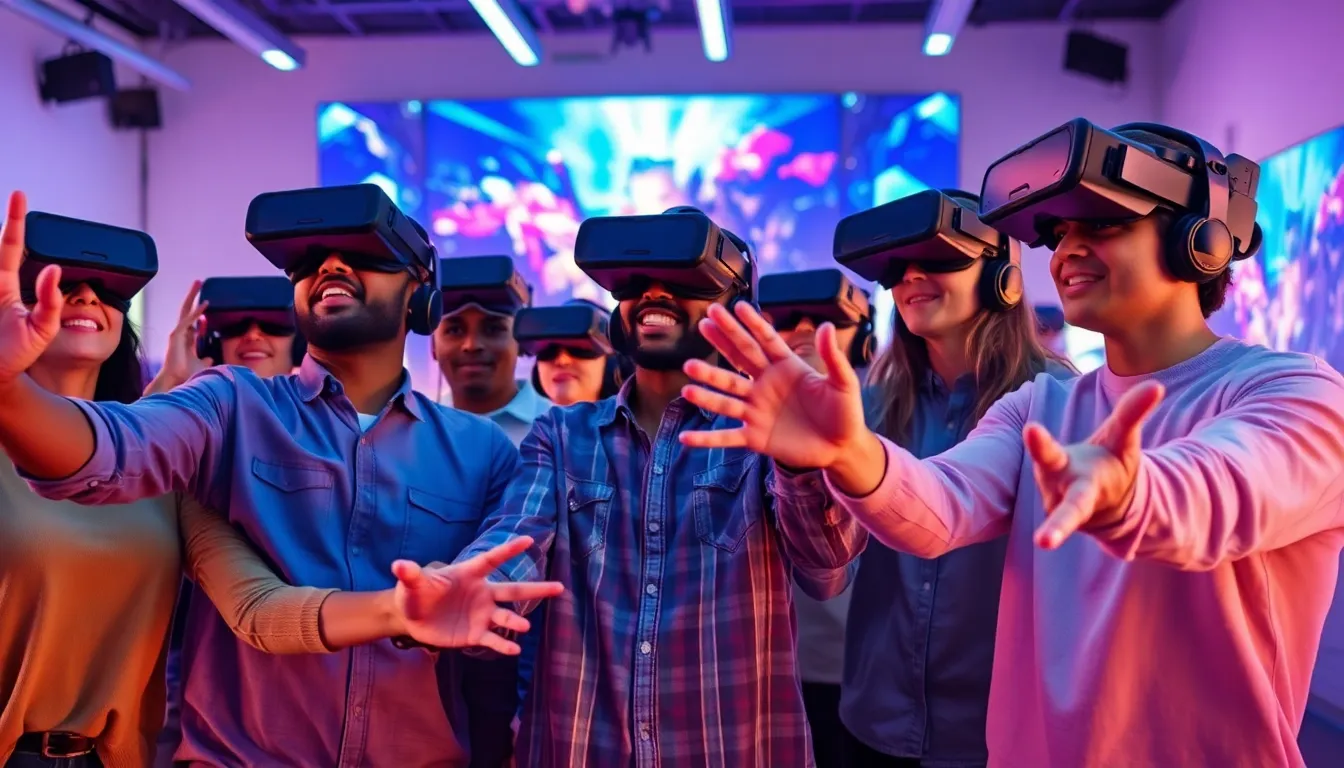Imagine stepping into a story where you’re not just a spectator but the main character. Welcome to the world of VR narrative storytelling, where the boundaries of imagination blur and reality takes a backseat. It’s like diving headfirst into your favorite book, but instead of flipping pages, you’re living the plot—complete with immersive environments and characters that seem to breathe.
In this brave new world, storytelling isn’t just about words; it’s about experiences. From epic adventures to heartwarming tales, VR transforms narratives into interactive journeys. So, grab your headset and get ready to explore how this cutting-edge technology is reshaping the way stories are told and experienced. After all, who wouldn’t want to be the hero of their own story while sipping virtual coffee?
Table of Contents
ToggleOverview of VR Narrative Storytelling
VR narrative storytelling immerses individuals in rich, engaging environments where they assume the role of protagonists. This innovative format transforms passive viewers into active participants, fostering deeper emotional connections with the story. Interactivity stands as a key element, allowing choices to influence plot outcomes, enhancing user agency.
Developers utilize advanced technologies to create lifelike worlds, offering users unparalleled sensory experiences. These environments often reflect a mix of artistic design and realistic details, which capture attention and draw individuals into the narrative. Emotional storytelling is enhanced through sound, visuals, and haptic feedback that provide an immersive experience.
Several notable VR storytelling platforms have emerged, showcasing the potential of the medium. Experiences range from cinematic narratives to educational simulations, each engaging users in unique ways. Successful examples include VR games like “Half-Life: Alyx,” which combines action with storytelling, and “The Walking Dead: Saints & Sinners,” which incorporates moral decisions into gameplay.
Empirical studies show that VR storytelling can impact memory retention positively. Users often report stronger emotional responses and a greater sense of presence in narratives experienced in virtual reality compared to traditional formats. As technology continues to evolve, the scope of VR narrative storytelling expands, inviting creators to explore new horizons and audiences to engage with compelling stories like never before.
Explorations of identity and perspective encourage users to confront real-world issues. The intersection of VR technology and narrative opens avenues for diverse storytelling, democratizing access to unique viewpoints. As storytelling in VR matures, it promises to redefine how narratives are crafted and consumed, leading to innovative experiences that resonate with a broad range of audiences.
The Evolution of Storytelling in VR

VR storytelling evolves with innovations in technology and changes in audience expectations. Users increasingly demand more immersive experiences that allow them to engage actively with narratives.
Historical Context
Early storytelling relied heavily on oral traditions and written texts to convey narratives. The transition to visual storytelling marked a significant shift, bringing films and television into popular culture. Virtual reality emerged in the mid-20th century, yet it took decades for the technology to become accessible. The advent of consumer-grade VR in the 2010s opened new doors for storytellers, creating opportunities for interactive experiences. As VR gains traction, its applications in gaming, education, and entertainment reveal an ever-expanding landscape for narrative exploration.
Key Technological Advances
Major advancements in VR technology enhance storytelling capabilities. First, improved graphics and processing power allow for stunning visual environments. Second, developments in motion tracking enable users to engage with virtual worlds more naturally. Third, spatial audio creates realistic soundscapes, deepening immersion. Fourth, haptic feedback technology provides tangible sensations, heightening emotional responses. Lastly, cloud computing facilitates complex interactions and larger narratives. These technological strides transform storytelling, making it more interactive and personalized while elevating overall user engagement.
Elements of Effective VR Narratives
Effective VR narratives rely on key elements that enhance user experience. Two primary components are immersion and interactivity, along with emotional engagement.
Immersion and Interactivity
Immersion captivates users by placing them in fully realized environments. Rich, detailed settings provide context and depth, allowing users to explore at their own pace. Interactivity empowers users to make choices that affect story outcomes. By engaging directly with the narrative, they experience a heightened sense of agency. Dynamic environments react to user actions, creating pathways for exploration and discovery. Developers focus on intuitive controls, ensuring that users can easily navigate these worlds. Engaging soundscapes further enhance immersion, drawing users into the experience.
Emotional Engagement
Emotional engagement forms the cornerstone of compelling narratives. VR creates opportunities for meaningful connections between users and characters. Users can experience empathy through first-person perspectives, deeply understanding character motivations. Story arcs crafted with emotional highs and lows resonate strongly, making narratives memorable. Developers utilize storytelling techniques that elicit strong feelings, guiding users through their emotional journeys. Personal stakes enhance the experience, fostering investment in narrative outcomes. Users often recall these experiences vividly, as emotional resonance sticks with them long after the VR session ends.
Case Studies in VR Narrative Storytelling
VR narrative storytelling showcases a diverse array of successful and challenging experiences that illustrate its potential and pitfalls in the industry.
Successful VR Story Experiences
“Half-Life: Alyx” exemplifies a successful VR experience, combining engaging storytelling with immersive gameplay. In this title, players explore a richly detailed world while making impactful decisions that shape their journey. Another notable example, “The Walking Dead: Saints & Sinners,” presents players with moral dilemmas, creating emotional stakes in a post-apocalyptic setting. Players connect with characters through interactivity, enhancing their investment in the narrative. Ultimately, these titles demonstrate how effective VR storytelling can leverage user agency to create memorable experiences.
Lessons Learned from Failures
Several failed VR projects provide insight into the challenges of VR narrative storytelling. “The Invisible Hours,” despite its unique premise, faced criticism for lack of interactivity, resulting in disengaged users. Another shortcoming was observed in “Monster of the Deep: Final Fantasy XV,” where clunky controls hindered immersion. Lessons from these failures highlight the importance of balancing narrative depth with user engagement. Developers must prioritize audience interaction, ensuring that users feel empowered to influence the story. Understanding these drawbacks paves the way for more innovative and compelling VR experiences in the future.
Future Trends in VR Narrative Storytelling
Advancements in VR technology lead to increasingly interactive experiences. Users expect richer, more engaging narratives that allow for deeper emotional connections. Personalization emerges as a significant trend, enabling tailored story arcs based on individual user choices.
Analytical data shows how artificial intelligence plays a growing role in crafting dynamic narratives. AI can adapt storylines in real-time, responding to user actions and decisions, thus creating unique experiences. This shift from linear storytelling to adaptive story structures fosters greater user engagement.
Development of multiplayer VR experiences is another trend gaining traction. Users can collaborate or compete in shared environments, enhancing social interactions within narratives. This communal aspect increases emotional investment and allows for diverse storytelling perspectives.
Moreover, integration of augmented reality (AR) with VR storytelling opens new avenues for engagement. Blending virtual elements with the real world creates immersive experiences that enhance narrative depth. This fusion encourages users to navigate their surroundings while participating in story-driven scenarios.
Continued focus on accessibility ensures that VR storytelling reaches broader audiences. Developers are actively incorporating features for those with disabilities, making narratives more inclusive. This commitment to accessibility enhances user satisfaction and promotes a diverse range of stories.
As analysis indicates, cross-media storytelling will become even more prevalent. Combining traditional media, like film or books, with VR can expand narrative universes. Audiences can explore different aspects of stories through varied formats, enhancing overall immersion.
The potential for incorporating biosensors adds another layer of personalization to narratives. Tracking physiological responses enables narratives to adapt according to users’ emotional states. This level of interactivity could elevate emotional engagement and create truly memorable experiences.
The future of VR narrative storytelling is bright and full of potential. As technology advances users can expect even more immersive and personalized experiences that resonate on an emotional level. By placing individuals in the heart of the story developers are not just creating entertainment but also fostering empathy and understanding through diverse narratives.
The ongoing evolution in VR storytelling promises to challenge traditional boundaries and redefine how stories are told and experienced. With each new innovation the possibilities for deeper engagement and interaction expand, paving the way for unforgettable journeys that captivate audiences worldwide.




